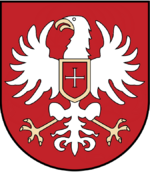User:Luziyca/Sandbox: Difference between revisions
No edit summary |
No edit summary |
||
| Line 1: | Line 1: | ||
== | {{Infobox political post | ||
[[ | |post = President | ||
|body = West Miersa | |||
|nativename = Prezydent Federacji Mierski ({{wp|Polish language|Miersan}}) | |||
|flag = West_Miersa_arms.png | |||
|flagsize = 150px | |||
|flagborder = | |||
|flagcaption = Emblem | |||
|department = | |||
|image = Jarosław_Kaczyński_Sejm_2016a_(cropped).JPG | |||
|alt = | |||
|incumbent = [[Sylwester Wrzesiński]] | |||
|incumbentsince = 3 October, 2016 | |||
|style = | |||
|residence = | |||
|nominator = | |||
|member_of = | |||
|appointer = | |||
|termlength = Two terms (maximum, five-year terms) | |||
|termlength_qualified = | |||
|constituting_instrument = [[Constitution of West Miersa]] | |||
|inaugural = [[Świętosław Wojdyla]] | |||
|formation = 3 October, 1936 | |||
|last = | |||
|abolished = | |||
|succession = | |||
|deputy = [[Minister-President of West Miersa]] | |||
|salary = | |||
|website = | |||
}} | |||
The '''President of the Miersan Federation''' ({{wp|Polish language|Miersan}}: ''Prezydent Federacji Mierski''), commonly known as the '''President of West Miersa''' (''Prezydent Mierski Zachodniej'') is the {{wp|head of state}} of the [[West Miersa|Miersan Federation]]. Created in 1936 with the establishment of West Miersa, it was constitutionally defined as being the head of state, but over the decades has also become the {{wp|de-facto}} {{wp|head of government}}. | |||
==History== | |||
With the independence of West Miersa from [[Narozalica]] following the implementation of the [[Godfredson Plan]] in 1936, the drafters of the [[Constitution of West Miersa|West Miersan constitution]] sought to create a {{wp|head of state}} modelled on the [[President of Narozalica|Narozalic Presidency]], elected every five years by the people of the Miersan Federation. However, unlike Narozalica, the framers decided to institute term limits, with each President only being re-elected once. | |||
Although the Presidency was not intended to be as centralised as the Narozalic Presidency, with powers being distributed to the [[National Assembly (West Miersa)|legislature]] and the [[Administrative divisions of West Miersa|voivodeships]], following the accession of [[Świętosław Wojdyla]] to the Presidency in 1936, Wojdyla centralised powers in the Presidency, enabling a domination of West Miersan politics by the [[Wojdyla family]] from independence until 1986: by the time of the [[Miersan War]] in 1979, the President was by far the {{wp|de-facto}} {{wp|head of government}}, with the [[Minister-President of West Miersa|Minister-President]] effectively being a puppet of the President. | |||
{{ | |||
In the 2000s, many of the de-facto powers of the Presidency were "granted" to the Minister-President by [[Tomisław Sobolewski]], who delegated powers to [[Oskar Palubicki]]. However, following the election of [[Gerard Wojdyla]] to the Minister-Presidency in 2011, Sobolewski and Gerard Wojdyla engaged in a power struggle that ultimately lead to Sobolewski resigning in 2013 after the Narozalic government backed Wojdyla. However, in 2016, after Wojdyla was succeeded as President by incumbent [[Sylwester Wrzesiński]], Wrzesiński was able to reverse the liberalisation made by Sobolewski. | |||
==Role== | |||
Under the [[Constitution of West Miersa|West Miersan constitution]], the President functions as the {{wp|head of state}} of the [[West Miersa|Miersan Federation]]. | |||
(TBC) | |||
Revision as of 06:56, 8 August 2020
| President of West Miersa | |
|---|---|
 Emblem | |
| Term length | Two terms (maximum, five-year terms) |
| Constituting instrument | Constitution of West Miersa |
| Inaugural holder | Świętosław Wojdyla |
| Formation | 3 October, 1936 |
| Deputy | Minister-President of West Miersa |
The President of the Miersan Federation (Miersan: Prezydent Federacji Mierski), commonly known as the President of West Miersa (Prezydent Mierski Zachodniej) is the head of state of the Miersan Federation. Created in 1936 with the establishment of West Miersa, it was constitutionally defined as being the head of state, but over the decades has also become the de-facto head of government.
History
With the independence of West Miersa from Narozalica following the implementation of the Godfredson Plan in 1936, the drafters of the West Miersan constitution sought to create a head of state modelled on the Narozalic Presidency, elected every five years by the people of the Miersan Federation. However, unlike Narozalica, the framers decided to institute term limits, with each President only being re-elected once.
Although the Presidency was not intended to be as centralised as the Narozalic Presidency, with powers being distributed to the legislature and the voivodeships, following the accession of Świętosław Wojdyla to the Presidency in 1936, Wojdyla centralised powers in the Presidency, enabling a domination of West Miersan politics by the Wojdyla family from independence until 1986: by the time of the Miersan War in 1979, the President was by far the de-facto head of government, with the Minister-President effectively being a puppet of the President.
In the 2000s, many of the de-facto powers of the Presidency were "granted" to the Minister-President by Tomisław Sobolewski, who delegated powers to Oskar Palubicki. However, following the election of Gerard Wojdyla to the Minister-Presidency in 2011, Sobolewski and Gerard Wojdyla engaged in a power struggle that ultimately lead to Sobolewski resigning in 2013 after the Narozalic government backed Wojdyla. However, in 2016, after Wojdyla was succeeded as President by incumbent Sylwester Wrzesiński, Wrzesiński was able to reverse the liberalisation made by Sobolewski.
Role
Under the West Miersan constitution, the President functions as the head of state of the Miersan Federation.
(TBC)
